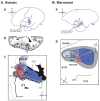Cortical representations of pitch in monkeys and humans
- PMID: 16842992
- PMCID: PMC4325365
- DOI: 10.1016/j.conb.2006.07.001
Cortical representations of pitch in monkeys and humans
Abstract
Pitch perception is crucial for vocal communication, music perception, and auditory object processing in a complex acoustic environment. How pitch is represented in the cerebral cortex has for a long time remained an unanswered question in auditory neuroscience. Several lines of evidence now point to a distinct non-primary region of auditory cortex in primates that contains a cortical representation of pitch.
Figures


References
-
- Plack CJ, Oxenham AJ, Fay RR, Popper AN. Pitch: Neural coding and perception. Springer handbook of auditory research. 2005
-
- Griffiths TD, Uppenkamp S, Johnsrude I, Josephs O, Patterson RD. Encoding of the temporal regularity of sound in the human brainstem. Nat Neurosci. 2001;4(6):633–7. - PubMed
-
- Patterson RD, Uppenkamp S, Johnsrude IS, Griffiths TD. The processing of temporal pitch and melody information in auditory cortex. Neuron. 2002;36(4):767–76. By comparing IRN and noise responses in an fMRI experiment, the authors identify a restricted region of auditory cortex sensitive to temporal regularity in lateral Heschl’s gyrus. A cortical region sensitive to pitch variation (melody) was found anterior to this identified pitch center. - PubMed
-
- Penagos H, Melcher JR, Oxenham AJ. A neural representation of pitch salience in nonprimary human auditory cortex revealed with functional magnetic resonance imaging. J Neurosci. 2004;24(30):6810–5. The authors demonstrate that the pitch center found in lateral Heschl’s gyrus is sensitive to the salience of a sound’s pitch. In addition, these authors use a noise masker to rule out the possibility of the BOLD signal in the pitch center resulting from combination tones. - PMC - PubMed
-
- Gutschalk A, Patterson RD, Scherg M, Uppenkamp S, Rupp A. Temporal dynamics of pitch in human auditory cortex. Neuroimage. 2004;22(2):755–66. - PubMed
Publication types
MeSH terms
Grants and funding
LinkOut - more resources
Full Text Sources

